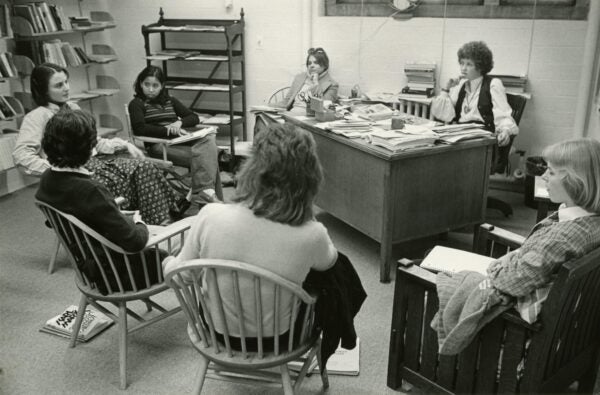From incarceration to inspiration

Herzog, Bradford F. Education Department. 1978. 6 3/4 x 10 1/8 in. Wellesley College Archives Image Gallery.
JSTOR Access in Prison marked the end of 2023 by launching its 1,000th site in the Washington State Department of Corrections. Over the past two years, we have worked with more than 700 college programs, Departments of Corrections, jails, educators, librarians, advocates, and our colleagues at JSTOR and Ithaka S+R to bring JSTOR access to nearly 500,000 people incarcerated on four continents. Early in 2022, I could count all our sites on my fingers and toes—and have a few digits left over. All of the sites were using an offline index to search JSTOR and request articles, and offering an online version of JSTOR inside prisons was bold—audacious even. The Wall of Ignorance recounts our uncertainty as we pushed off on this journey together.
I was certain of one thing, though: the importance of the work. My relationship with JSTOR began with the offline index during my own time in prison. JSTOR was more than just access to articles and books; it was a gateway to a world I thought I had lost, and the infinite possibilities of the new world waiting for me on the other side of the fence. I tap into that wonderment when I am tired, or a project has stalled, because I want everyone wearing a correctional uniform to experience the same sense of possibility I did.
Celebrating 1,000 sites and 430,000 people in prison with JSTOR access
I am so happy the Washington State Department of Corrections is sharing this moment. Along with Arizona and Wisconsin, Washington’s DOC was one of my “first three” state systems to review JSTOR Access in Prison’s online iterations prior to launch. They provided feedback, and gave us the insight we needed to break down The Wall of Ignorance and build the moderated version that now works in eight countries.
Our initial goal was to reach students pursuing higher education inside prisons, including those benefiting from expanded Second Chance Pell opportunities. We discovered that GED students are some of the most engaged, so expanded our vision to ensure anyone engaging with education—whether formal or asynchronous—should have access to JSTOR while incarcerated. We included tablets, and the Massachusetts Department of Corrections became our first site to incorporate JSTOR Access in Prison onto those devices and go live. It was this latest iteration of the program that moved the needle to more than 430,000 people in prison who now have access to JSTOR.
Since the first thumb drive was installed in 2007, JSTOR Access in Prison has revolutionized how incarcerated individuals engage with education. The offline index, offering the 500,000 most-cited articles, is not just a collection of academic papers; it’s a lifeline to a world of knowledge, critical thinking, and self-improvement. It’s about opening doors that many thought were permanently closed. With the addition of tablets, we are seeing sites migrate from the offline index to digital delivery of articles—and students benefit from digital dexterity— seamlessly moving between platforms to bridge the digital divide. This skill is especially crucial for people who may encounter smart phones and computers in the real world for the first time once released.
Continuing our mission, setting new goals
This milestone of 1,000 sites is a collective achievement. It embodies the hard work of educators, correctional facilities staff, and the belief in fair chances. It’s a reflection of what we can achieve when we come together to support and uplift each other, regardless of our past. It is a reflection of the values instilled in every single person working at ITHAKA who selflessly gave JSTOR Access in Prison their time and expertise to make this milestone possible.
While today we celebrate, tomorrow we continue our mission. We are committed to breaking down barriers and ensuring that education is a right, not a privilege, regardless of where you are. There are 2.2 million people incarcerated in the United States; I hope to reach half of them by this time next year.
As I reflect on this journey from incarcerated learner to leading the very initiative that gave me so much, I am filled with hope. This 1,000th site activation is more than a number; it’s a testament to resilience, change, and the unwavering power of education. Together, we can continue to make a difference, one life, one article, one site at a time.